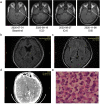Case report: Leptomeningeal metastasis of advanced nasopharyngeal carcinoma treated with chemoimmunotherapy
- PMID: 38111107
- PMCID: PMC10732638
- DOI: 10.1080/21645515.2023.2294579
Case report: Leptomeningeal metastasis of advanced nasopharyngeal carcinoma treated with chemoimmunotherapy
Abstract
Leptomeningeal metastasis (LM) of nasopharyngeal carcinoma (NPC) is rare and associated with a poor prognosis. Immune checkpoint inhibitors (ICIs) have been the standard first-line treatment for metastatic NPC, but their effect on meningeal metastasis of NPC needs further investigation. A 38-year-old man complained of bilateral neck masses and sought medical care. He was diagnosed with nasopharyngeal undifferentiated non-keratinizing carcinoma with bilateral cervical lymph node metastasis and multiple bone metastasis, stage cT4N2M1 IVb. Then, the patient received first-line anti-PD-1 antibody tislelizumab combined with gemcitabine and cisplatin and achieved partial response. After seven cycles of first-line chemoimmunotherapy, the patient subsequently developed neurological symptoms, including unsteady walking, slurred speech, coughing on drinking, and unconsciousness. MRI showed leptomeningeal linear enhancement, and cerebrospinal fluid (CSF) analysis indicated Epstein-Barr virus (EBV) infection and squamous cell carcinoma cytology, suggesting the diagnosis of leptomeningeal metastasis. After the definite diagnosis of LM, the patient's condition deteriorated rapidly, leading to his death from brain herniation. We reported the first case of advanced NPC with pathologically confirmed leptomeningeal metastasis after receiving first-line chemoimmunotherapy. Considering the poor prognosis of LM, it is suggested to perform MRI and CSF examination when patients have neurological symptoms. Although immunotherapy significantly improved survival outcomes of advanced NPC patients, it seemed not effective in the setting of LM. The effect of other treatment options, such as radiation therapy and intrathecal therapy, requires further verification.
Keywords: EBV; Nasopharyngeal carcinoma; cerebrospinal fluid; immunotherapy; leptomeningeal metastasis.
Conflict of interest statement
No potential conflict of interest was reported by the author(s).
Figures



References
-
- Hsu C, Lee SH, Ejadi S, Even C, Cohen RB, Le Tourneau C, Mehnert JM, Algazi A, van Brummelen EMJ, Saraf S, et al. Safety and antitumor activity of pembrolizumab in patients with programmed death-ligand 1–positive nasopharyngeal carcinoma: results of the KEYNOTE-028 study. J Clin Oncol. 2017;35(36):4050–6. doi:10.1200/JCO.2017.73.3675. - DOI - PubMed
-
- Ma BBY, Lim WT, Goh BC, Hui EP, Lo KW, Pettinger A, Foster NR, Riess JW, Agulnik M, Chang AYC, et al. Antitumor activity of nivolumab in recurrent and metastatic nasopharyngeal carcinoma: an international, multicenter study of the mayo clinic phase 2 consortium (NCI-9742). JCO. 2018;36(14):1412–8. doi:10.1200/JCO.2017.77.0388. - DOI - PMC - PubMed
Publication types
MeSH terms
LinkOut - more resources
Full Text Sources
